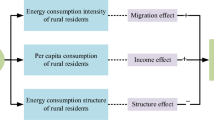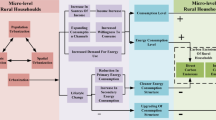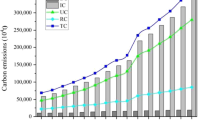Abstract
Residential indirect carbon emissions (RICE) are the major contributor to carbon emissions from the household sector. Regional RICE inequality has gradually become the focus of current issues. This paper has accounted for the RICE level of each province in China from 2010 to 2020 and assessed the RICE inequality at different regional scales employing the Theil index. Additionally, this paper presents a comprehensive analysis of RICE inequality across three dimensions: region, consumption category, and driving factors, illustrating the principal sources and determinants of RICE inequality. The results indicate the following: (1) RICE inequality in China is generally on a downward trend. (2) The gap between eastern China and the other regions is the dominant source of RICE inequality. (3) Residence consumption affects RICE inequality far more than other consumption categories. (4) Disposable income and the urban–rural structure of the population are the predominant factors affecting RICE inequality for most regions. The consumption propensity effect has a relatively pronounced impact on RICE inequality in the central and western regions. Based on the analysis, local governments ought to focus on economic construction, promote urbanization, and regulate the housing market to alleviate the RICE inequality.






Similar content being viewed by others
Data availability
The datasets generated or analyzed during this study are available from the corresponding author upon reasonable request.
References
Ang BW (2005) The LMDI approach to decomposition analysis: a practical guide. Energy Policy 33:867–871. https://doi.org/10.1016/j.enpol.2003.10.010
Bianco V, Cascetta F, Marino A, Nardini S (2019) Understanding energy consumption and carbon emissions in Europe: a focus on inequality issues. Energy 170:120–130. https://doi.org/10.1016/j.energy.2018.12.120
Bin S, Dowlatabadi H (2005) Consumer lifestyle approach to US energy use and the related CO2 emissions. Energy Policy 33:197–208. https://doi.org/10.1016/S0301-4215(03)00210-6
Chen JD, Cheng SL, Song ML, Wang J (2016) Interregional differences of coal carbon dioxide emissions in China. Energy Policy 96:1–13. https://doi.org/10.1016/j.enpol.2016.05.015
Chen JD, Cheng SL, Song ML (2017) Decomposing inequality in energy-related CO2 emissions by source and source increment: the roles of production and residential consumption. Energy Policy 107:698–710. https://doi.org/10.1016/j.enpol.2017.05.003
Chen GW, Zhu YH, Wiedmann T, Yao LN, Xu LX, Wang YF (2019) Urban-rural disparities of household energy requirements and influence factors in China: classification tree models. Appl Energy 250:1321–1335. https://doi.org/10.1016/j.apenergy.2019.04.170
Chen L, Xu LY, Yang ZF (2019) Inequality of industrial carbon emissions of the urban agglomeration and its peripheral cities: a case in the Pearl River Delta. China Renew Sust Energ Rev 109:438–447. https://doi.org/10.1016/j.rser.2019.04.010
Cheng SL, Fan W, Zhang J, Wang N, Meng FX, Liu GY (2021) Multi-sectoral determinants of carbon emission inequality in Chinese clustering cities. Energy 214:9. https://doi.org/10.1016/j.energy.2020.118944
Clarke-Sather A, Qu JS, Wang Q, Zeng JJ, Li Y (2011) Carbon inequality at the sub-national scale: a case study of provincial-level inequality in CO2 emissions in China 1997–2007. Energy Policy 39:5420–5428. https://doi.org/10.1016/j.enpol.2011.05.021
Du G, Sun CW, Fang ZN (2015) Evaluating the Atkinson index of household energy consumption in China. Renew Sust Energ Rev 51:1080–1087. https://doi.org/10.1016/j.rser.2015.07.017
Duro JA (2012) On the automatic application of inequality indexes in the analysis of the international distribution of environmental indicators. Ecol Econ 76:1–7. https://doi.org/10.1016/j.ecolecon.2011.12.019
Duro JA, Padilla E (2006) International inequalities in per capita CO2 emissions: a decomposition methodology by Kaya factors. Energy Economics 28:170–187. https://doi.org/10.1016/j.eneco.2005.12.004
Gomez DR, Wattersson J, Americano B, Ha C, Marland G, Matsika E, Namayanga L, Osman B, Saka J, Treanton K (2008) Chapter 2, Energy, 2006 IPCC Guidelines for National Greenhouse Gas Emissions Inventories. Intergovernmental Panel on Climate Change. https://www.ipcc-nggip.iges.or.jp/public/2006gl/vol2.html. Accessed 30 Sept 2022
Grunewald N, Jakob M, Mouratiadou I (2014) Decomposing inequality in CO2 emissions: the role of primary energy carriers and economic sectors. Ecol Econ 100:183–194. https://doi.org/10.1016/j.ecolecon.2014.02.007
Guo DY, Chen H, Long RY, Ni YZ (2018) An integrated measurement of household carbon emissions from a trading-oriented perspective: a case study of urban families in Xuzhou, China. J Clean Prod 188:613–624. https://doi.org/10.1016/j.jclepro.2018.04.025
Hertwich EG, Peters GP (2009) Carbon footprint of nations: a global, trade-linked analysis. Environ Sci Technol 43:6414–6420. https://doi.org/10.1021/es803496a
Huang YZ, Matsumoto K (2021) Drivers of the change in carbon dioxide emissions under the progress of urbanization in 30 provinces in China: a decomposition analysis. J Clean Prod 322:16. https://doi.org/10.1016/j.jclepro.2021.129000
IEA (2021) Global energy review: CO2 emissions in 2021. International Energy Agency. https://www.iea.org/reports/global-energy-review-co2-emissions-in-2021-2. Accessed 30 Sept 2022
Liu XY, Wang XE, Song JN, Wang HN, Wang SO (2019) Indirect carbon emissions of urban households in China: patterns, determinants and inequality. J Clean Prod 241:14. https://doi.org/10.1016/j.jclepro.2019.118335
Liu J, Li S, Ji Q (2021) Regional differences and driving factors analysis of carbon emission intensity from transport sector in China. Energy 224:120178. https://doi.org/10.1016/j.energy.2021.120178
Luo G, Baležentis T, Zeng S (2023) Per capita CO2 emission inequality of China’s urban and rural residential energy consumption: a Kaya-Theil decomposition. J Environ Manage 331:117265. https://doi.org/10.1016/j.jenvman.2023.117265
Mi ZF, Meng J, Green F, Coffman DM, Guan DB (2018) China’s “exported carbon” peak: patterns, drivers, and implications. Geophys Res Lett 45:4309–4318. https://doi.org/10.1029/2018GL077915
National Bureau of Statistics (2021) China input-output table. National Bureau of Statistics of China. https://data.stats.gov.cn/ifnormal.htm?u=/files/html/quickSearch/trcc/trcc01.html&h=740. Accessed 1 Sept 2022
National Bureau of Statistics (2022) China Statistical Yearbook. National Bureau of Statistics of China. http://www.stats.gov.cn/sj/ndsj/. Accessed 1 Sept 2022
Pakrooh P, Hayati B, Pishbahar E, Nematian J, Brannlund ER (2020) Focus on the provincial inequalities in energy consumption and CO2 emissions of Iran’s agriculture sector. Sci Total Environ 715:137029. https://doi.org/10.1016/j.scitotenv.2020.137029
Roxon J, Ulm FJ, Pellenq RJM (2020) Urban heat island impact on state residential energy cost and CO2 emissions in the United States. Urban Climate 31:100546. https://doi.org/10.1016/j.uclim.2019.100546
Sinha A, Balsalobre-Lorente D, Zafar MW, Saleem MM (2022) Analyzing global inequality in access to energy: developing policy framework by inequality decomposition. J Environ Manage 304:114299. https://doi.org/10.1016/j.jenvman.2021.114299
Teixido-Figueras J, Duro JA (2015) The building blocks of international ecological footprint inequality: a regression-based decomposition. Ecol Econ 118:30–39. https://doi.org/10.1016/j.ecolecon.2015.07.014
Wang ZH, Yang L (2014) Indirect carbon emissions in household consumption: evidence from the urban and rural area in China. J Clean Prod 78:94–103. https://doi.org/10.1016/j.jclepro.2014.04.041
Wang H, Zhou P (2018) Assessing global CO2 emission inequality from consumption perspective: an index decomposition analysis. Ecol Econ 154:257–271. https://doi.org/10.1016/j.ecolecon.2018.08.008
Wang C, Zhan JY, Li ZH, Zhang F, Zhang Y (2019) Structural decomposition analysis of carbon emissions from residential consumption in the Beijing-Tianjin-Hebei region, China. J Clean Prod 208:1357–1364. https://doi.org/10.1016/j.jclepro.2018.09.257
Wei YM, Liu LC, Fan Y, Wu G (2007) The impact of lifestyle on energy use and CO(2) emission: an empirical analysis of China’s residents. Energy Policy 35:247–257. https://doi.org/10.1016/j.enpol.2005.11.020
Xin-gang Z, Fan L (2019) Spatial distribution characteristics and convergence of China’s regional energy intensity: an industrial transfer perspective. J Clean Prod 233:903–917. https://doi.org/10.1016/j.jclepro.2019.06.073
Xu C (2020) Determinants of carbon inequality in China from static and dynamic perspectives. J Clean Prod 277:123286. https://doi.org/10.1016/j.jclepro.2020.123286
Xu C (2023) Economic inequality and carbon inequality: multi-evidence from China’s cities and counties. J Environ Manage 327:116871. https://doi.org/10.1016/j.jenvman.2022.116871
Xu X, Han L, Lv X (2016) Household carbon inequality in urban China, its sources and determinants. Ecol Econ 128:77–86. https://doi.org/10.1016/j.ecolecon.2016.04.015
Yang Y, Yang S (2020) Are industrial carbon emissions allocations in developing regions equitable? A case study of the northwestern provinces in China. J Environ Manage 265:110518. https://doi.org/10.1016/j.jenvman.2020.110518
Yuan B, Ren S, Chen X (2015) The effects of urbanization, consumption ratio and consumption structure on residential indirect CO2 emissions in China: a regional comparative analysis. Appl Energy 140:94–106. https://doi.org/10.1016/j.apenergy.2014.11.047
Zhang H, Li S (2022) Carbon emissions’ spatial-temporal heterogeneity and identification from rural energy consumption in China. J Environ Manage 304:114286. https://doi.org/10.1016/j.jenvman.2021.114286
Zhao M, Chan HS (2022) Can inequality reduction decrease carbon emissions in China? A counterfactual analysis. J Environ Manage 322:116089. https://doi.org/10.1016/j.jenvman.2022.116089
Zhong H, Feng K, Sun L, Cheng L, Hubacek K (2020) Household carbon and energy inequality in Latin American and Caribbean countries. J Environ Manage 273:110979. https://doi.org/10.1016/j.jenvman.2020.110979
Author information
Authors and Affiliations
Contributions
Lei Wen: conceptualization, validation, supervision, investigation, writing — review and editing. Wenkai Jiang: methodology, visualization, data curation, formal analysis, writing — original draft.
Corresponding author
Ethics declarations
Ethics approval and consent to participate
Not applicable.
Consent for publication
Not applicable.
Competing interests
The authors declare no competing interests.
Additional information
Responsible Editor: V.V.S.S. Sarma
Publisher's Note
Springer Nature remains neutral with regard to jurisdictional claims in published maps and institutional affiliations.
Appendix A
Appendix A
Division of the four economic regions. Table 3.
Rights and permissions
Springer Nature or its licensor (e.g. a society or other partner) holds exclusive rights to this article under a publishing agreement with the author(s) or other rightsholder(s); author self-archiving of the accepted manuscript version of this article is solely governed by the terms of such publishing agreement and applicable law.
About this article
Cite this article
Wen, L., Jiang, W. Multidimensional analysis of the regional inequalities in indirect carbon emissions from China’s residential consumption. Environ Sci Pollut Res 30, 123570–123585 (2023). https://doi.org/10.1007/s11356-023-31023-4
Received:
Accepted:
Published:
Issue Date:
DOI: https://doi.org/10.1007/s11356-023-31023-4




